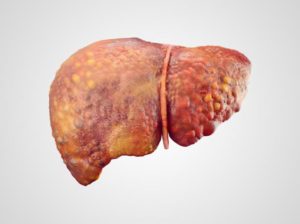 Cirrhosis is a complication of many liver diseases. It is a chronic condition in which the liver slowly deteriorates and malfunctions due to chronic injury. Scar tissue replaces healthy liver tissue, partially blocking the flow of blood through the liver.
Cirrhosis is a complication of many liver diseases. It is a chronic condition in which the liver slowly deteriorates and malfunctions due to chronic injury. Scar tissue replaces healthy liver tissue, partially blocking the flow of blood through the liver.
Fibrosis describes encapsulation or replacement of injured tissue by a collagenous scar. Liver fibrosis results from the perpetuation of the normal wound healing response resulting in an abnormal continuation of fibrogenesis (connective tissue production and deposition). Fibrosis progresses at variable rates depending on the cause of liver disease, environmental and host factors. Cirrhosis is an advanced stage of liver fibrosis that is accompanied by distortion of the hepatic vasculature.
It is a progressive disease, developing slowly over many years. If it is allowed to continue, the buildup of scar tissue can eventually stop liver function. For cirrhosis to develop, long-term, continuous damage to the liver needs to occur.
Scarring also impairs the liver’s ability to
- control infections
- remove bacteria and toxins from the blood
- process nutrients, hormones, and drugs
- make proteins that regulate blood clotting
- produce bile to help absorb fats including cholesterol and fat-soluble vitamins
A healthy liver is able to regenerate most of its own cells when they become damaged. With end-stage cirrhosis, the liver can no longer effectively replace damaged cells. A healthy liver is necessary for survival.
Cirrhosis is the twelfth leading cause of death by disease, accounting for 27,000 deaths each year. The condition affects men slightly more often than women.
- Cirrhosis has various causes. Cirrhosis is most commonly caused by alcoholism, hepatitis B and C, and fatty liver disease, but has many other possible causes. Some cases are idiopathic.
- Obesity is becoming a common cause of cirrhosis, either as the sole cause or in combination with alcohol, hepatitis C, or both. Many people with cirrhosis have more than one cause of liver damage. Cirrhosis is not caused by trauma to the liver or other acute, or short-term, causes of damage. Usually years of chronic injury are required to cause cirrhosis.
- Alcohol-related liver disease – Most people who consume alcohol do not suffer damage to the liver. But heavy alcohol use over several years can cause chronic injury to the liver. The amount of alcohol it takes to damage the liver varies greatly from person to person. For women, consuming two to three drinks—including beer and wine—per day and for men, three to four drinks per day, can lead to liver damage and cirrhosis. In the past, alcohol-related cirrhosis led to more deaths than cirrhosis due to any other cause. Deaths caused by obesity-related cirrhosis are increasing.
- Chronic hepatitis C – The hepatitis C virus is a liver infection that is spread by contact with an infected person’s blood. Chronic hepatitis C causes inflammation and damage to the liver over time that can lead to cirrhosis.
- Chronic hepatitis B and D – The hepatitis B virus is a liver infection that is spread by contact with an infected person’s blood, semen, or other body fluid. Hepatitis B, like hepatitis C, causes liver inflammation and injury that can lead to cirrhosis. The hepatitis B vaccine is given to all infants and many adults to prevent the virus. Hepatitis D is another virus that infects the liver and can lead to cirrhosis, but it occurs only in people who already have hepatitis B.
- Nonalcoholic fatty liver disease (NAFLD) – In NAFLD, fat builds up in the liver and eventually causes cirrhosis. This increasingly common liver disease is associated with obesity, diabetes, protein malnutrition, coronary artery disease, and corticosteroid medications.
- Autoimmune hepatitis – This form of hepatitis is caused by the body’s immune system attacking liver cells and causing inflammation, damage, and eventually cirrhosis. Researchers believe genetic factors may make some people more prone to autoimmune diseases. About 70 percent of those with autoimmune hepatitis are female.
- Diseases that damage or destroy bile ducts – Several different diseases can damage or destroy the ducts that carry bile from the liver, causing bile to back up in the liver and leading to cirrhosis. In adults, the most common condition in this category is primary biliary cirrhosis, a disease in which the bile ducts become inflamed and damaged and, ultimately, disappear. Secondary biliary cirrhosis can happen if the ducts are mistakenly tied off or injured during gallbladder surgery. Primary sclerosing cholangitis is another condition that causes damage and scarring of bile ducts. In infants, damaged bile ducts are commonly caused by Alagille syndrome or biliary atresia, conditions in which the ducts are absent or injured.
- Inherited diseases – Cystic fibrosis, alpha-1 antitrypsin deficiency, hemochromatosis, Wilson disease, galactosemia, and glycogen storage diseases are inherited diseases that interfere with how the liver produces, processes, and stores enzymes, proteins, metals, and other substances the body needs to function properly. Cirrhosis can result from these conditions.
- Drugs, toxins, and infections – Other causes of cirrhosis include drug reactions, prolonged exposure to toxic chemicals, parasitic infections, and repeated bouts of heart failure with liver congestion.
Many people with cirrhosis have no symptoms in the early stages of the disease. However, as the disease progresses, a person may experience the following symptoms:
- Loss of appetite
- Lack of energy (fatigue), which may be debilitating
- Nausea, vomiting
- Weight loss or sudden weight gain
- Bruises
- Yellowing of skin or the whites of eyes (jaundice)
- Itchy skin
- Fluid retention (edema) and swelling in the ankles, legs, and abdomen (often an early sign)
- abdominal pain and bloating
- spiderlike blood vessels on the skin
- A brownish or orange tint to the urine
- Light colored stools
- Confusion, disorientation, personality changes
- Blood in the stool
- Fever
As liver function deteriorates, one or more complications may develop. In some people, complications may be the first signs of the disease.
- Edema and ascites – When liver damage progresses to an advanced stage, fluid collects in the legs, called edema, and in the abdomen, called ascites. Ascites can lead to bacterial peritonitis, a serious infection.
- Bruising and bleeding – When the liver slows or stops producing the proteins needed for blood clotting, a person will bruise or bleed easily.
- Portal hypertension – Normally, blood from the intestines and spleen is carried to the liver through the portal vein. But cirrhosis slows the normal flow of blood, which increases the pressure in the portal vein. This condition is called portal hypertension.
- Esophageal varices and gastropathy – When portal hypertension occurs, it may cause enlarged blood vessels in the esophagus, called varices, or in the stomach, called gastropathy, or both. Enlarged blood vessels are more likely to burst due to thin walls and increased pressure. If they burst, serious bleeding can occur in the esophagus or upper stomach, requiring immediate medical attention.
- Splenomegaly – When portal hypertension occurs, the spleen frequently enlarges and holds white blood cells and platelets, reducing the numbers of these cells in the blood. A low platelet count may be the first evidence that a person has developed cirrhosis.
- Jaundice – Jaundice occurs when the diseased liver does not remove enough bilirubin from the blood, causing yellowing of the skin and whites of the eyes and darkening of the urine. Bilirubin is the pigment that gives bile its reddish-yellow color.
- Gallstones – If cirrhosis prevents bile from flowing freely to and from the gallbladder, the bile hardens as gallstones.
- Sensitivity to medications – Cirrhosis slows the liver’s ability to filter medications from the blood. When this occurs, medications act longer than expected and build up in the body. This causes a person to be more sensitive to medications and their side effects.
- Hepatic encephalopathy – A failing liver cannot remove toxins from the blood, and they eventually accumulate in the brain. The buildup of toxins in the brain—called hepatic encephalopathy—can decrease mental function and cause coma. Signs of decreased mental function include confusion, personality changes, memory loss, trouble concentrating, and a change in sleep habits.
- Insulin resistance and type 2 diabetes – Cirrhosis causes resistance to insulin—a hormone produced by the pancreas that enables the body to use glucose as energy. With insulin resistance, the body’s muscle, fat, and liver cells do not use insulin properly. The pancreas tries to keep up with the demand for insulin by producing more, but excess glucose builds up in the bloodstream causing type 2 diabetes.
- Liver cancer – Hepatocellular carcinoma is a type of liver cancer that can occur in people with cirrhosis. Hepatocellular carcinoma has a high mortality rate, but several treatment options are available.
- Other problems – Cirrhosis can cause immune system dysfunction, leading to the risk of infection. Cirrhosis can also cause kidney and lung failure, known as hepatorenal and hepatopulmonary syndromes.
The diagnosis of cirrhosis is usually based on the presence of a risk factor for cirrhosis, such as alcohol use or obesity, and is confirmed by physical examination, blood tests, and imaging. The steps in making the diagnosis of cirrhosis will include medical analysis of the following:
During a physical examination the health care provider may find:
- An enlarged liver or spleen
- Excess breast tissue
- Expanded (distended) abdomen, as a result of too much fluid
- Reddened palms
- Red spider-like blood vessels on the skin
- Small testicles
- Widened (dilated) veins in the abdomen wall
- Yellow eyes or skin (jaundice)
The following Blood Tests can reveal liver problems:
- Aminotransferases – AST and ALT are moderately elevated, with AST > ALT. However, normal aminotransferases do not preclude cirrhosis.
- Alkaline phosphatase – usually slightly elevated.
- Gamma-glutamyl transferase – correlates with AP levels. Typically much higher in chronic liver disease from alcohol.
- Bilirubin – may elevate as cirrhosis progresses.
- Albumin – levels fall as the synthetic function of the liver declines with worsening cirrhosis since albumin is exclusively synthesized in the liver
- Prothrombin time – increases since the liver synthesizes clotting factors.
- Globulins – increased due to shunting of bacterial antigens away from the liver to lymphoid tissue.
- Serum sodium – hyponatremia due to inability to excrete free water resulting from high levels of ADH and aldosterone.
- Thrombocytopenia – due to both congestive splenomegaly as well as decreased thrombopoietin from the liver. However, this rarely results in platelet count < 50,000/mL.
- Leukopenia and neutropenia – due to splenomegaly with splenic margination.
- Coagulation defects – the liver produces most of the coagulation factors and thus coagulopathy correlates with worsening liver disease.
The following tests may be used to evaluate the liver:
- Ultrasound of the abdomen
- CT scan or MRI (MRCP) scan
- Laparoscope
- Endoscopy to check for abnormal veins in the esophagus or stomach
- Radioisotope liver/spleen scan
- A liver biopsy confirms cirrhosis. Some patients will be screened for liver cancer.
Ayurveda Management of Liver cirrhosis
 The liver is called Yakrit in Ayurveda. Pitta is the predominant humor of the liver. Most liver disorders are aggravated conditions of Pitta. Excessive bile production or a blockage in the flow of bile usually indicates high pitta, which in turn affects the agni or enzyme activities responsible for absorption, digestion and metabolism.
The liver is called Yakrit in Ayurveda. Pitta is the predominant humor of the liver. Most liver disorders are aggravated conditions of Pitta. Excessive bile production or a blockage in the flow of bile usually indicates high pitta, which in turn affects the agni or enzyme activities responsible for absorption, digestion and metabolism.
Kumbha Kamala is the classical description if cirrhosis of liver in Ayurveda.
“|| Kaalantarath khareebhutah kruchrasyaat khumba kamala ||”
It is a neglected or untreated stage of jaundice or hepatitis, when becomes chronic, produces dry or roughness to the Liver (kharathva or rookshatva). It can become incurable if not attended immediately.
At CHARAKA, we are providing highly effective treatment for Liver Cirrhosis. Our treatment involves Shodana chikitsa (detoxification through Panchakarma procedures), Shamana chikitsa (Palliative researched Ayurvedic medicines) and Kayakalpa (rejuvenation). Our treatment is useful in improving the liver heath and preventing further damage.
Diet restrictions, life style modifications and de-addiction are also the essential factors practiced for the best possible results.

